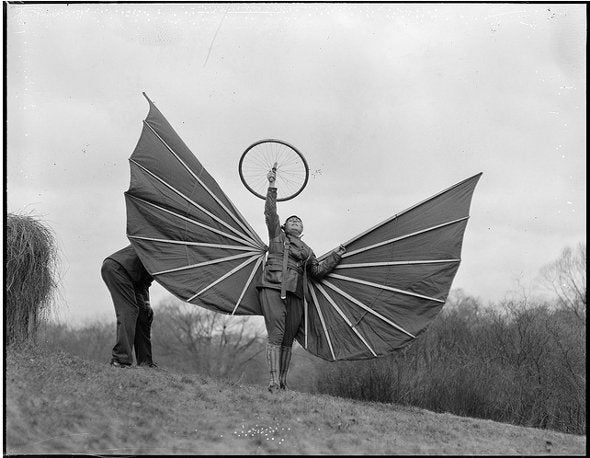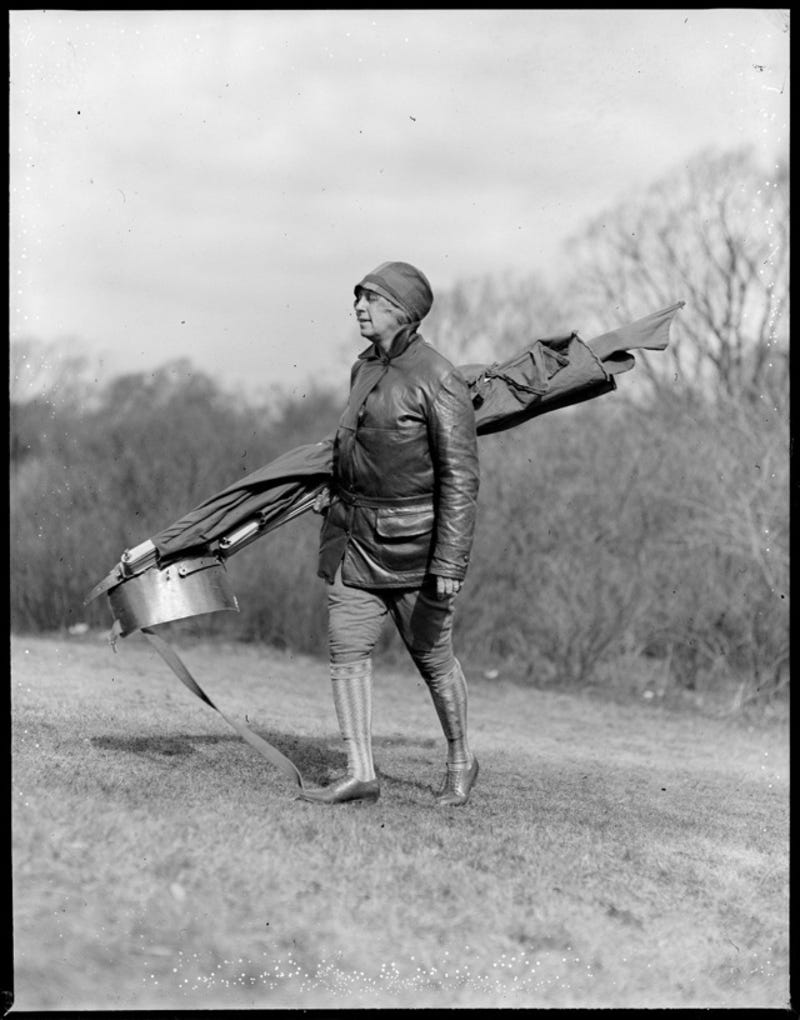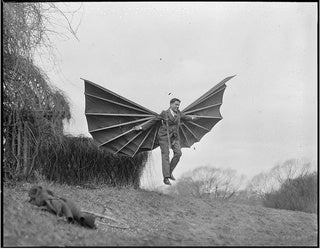
On a crisp April morning in 1931, a sturdy, middle-aged woman strode purposefully up a hillock overlooking the Spot Pond reservoir outside Boston, MA. Judging the wind conditions and checking that the newsreel cameras were rolling, Madame Helene Alberti adjusted her wings and prepared to launch herself skyward.
Born in Chicago in 1874, Madame Alberti had enjoyed some success as an opera singer and, occasionally, as a burlesque queen, at the turn of the 20th century. By the late 1920s, her singing career well behind her, she had developed a passion for rediscovering the “ancient Greek laws of cosmic motion”. This was a system of metaphysical culture that, she fervently believed, would ultimately allow humans to run tirelessly, lift tremendous weights and even fly like birds. If her latest experiments bore fruit, she planned to establish a school for instruction in her system.
As she explained to a Boston Herald reporter, “cosmic motion” was predicated on several key principles. First was the concept of “engines”; major nerve ganglia in certain parts of the body, most importantly the abdomen, the solar plexus and the base of the spine. These were engines in the sense that they generated energy to produce movement. To extend the analogy, the “ignition key” was the exertion of willpower, because, Madame Alberti reasoned, these nerve centers are connected to the brain and can thus be controlled by the mind.
Under the atomic theory of the structure of all substances, atoms are mostly holes. They are made of positive and negative charges of electricity, and the number grouping the weight of the charges, determine whether the atoms are the helium, which lifts the dirigible Los Angeles, or tin, or something else.’
As further proof that this theory has sound basis, Dr. Noyes points out that the whole structure of modern chemistry, which is creating articles by synthetic processes, has been erected upon it. Illustrating the emptiness of an atom, he said that if an atom of helium were to be magnified so that its centre or nucleus could be teed up on a golf course, the electrons which compose the remainder of the atom and which are supposed to revolve around it, would be on the green 200 yards away. In between would be tremendous forces of attraction and locked-up energy, which, however, are no more tangible than empty space.
Searing in mind, then, these tunnels or spaces between the molecules of the body, you can with the right thought contract the body to a state of solidity, and with relaxation expand it to a state or feeling of thin air without weight. You can take possession of your own body and make it obey your will.
Centralize your thought. Relax the whole outer body — wear it as a garment. Now, from that center begin to move, letting the force within you raise you up; feel yourself filled with energy. Now let it out slowly in rhythm; again, sideways, expanding the universal laws of forces around, above, beneath, and on either side of you.
The bodily motion of human flight was not, as some people conceived it, that of flapping the arms with wings attached to them, but of rhythmically rocking the torso back and forth. This would not be a purely muscular effort; the “engine” in the chest would pull the body forward and the one at the base of the spine would draw it back, and so on, ad infinitum. Put on wings – constructed to aeronautical principles – turn on the motive power, and up you go, just like an airplane or a bird.
Madame Alberti had, in fact, tested a set of wings as early as 1929. She and a young female assistant had made their way to Spot Pond early in the morning, before any curious bystanders might be about. Unfortunately, a strong wind had been blowing that day and their experimental wings, which had not been constructed in accordance with the latest aeronautical standards, eventually collapsed in the gale. Madame Alberti reported that she had, however, felt appreciably lighter while running with the wings, which was surely a sign that she was on the right track:
I have proved to my own satisfaction that these old Greek laws of motion, once understood, can be made to work today. I believe they can be made to hold practical value for us. That is what I am trying to demonstrate. If they have no practical value, they are no good.
I firmly believe the day is not far distant when we will be able to entrust our bodies to the air in the same manner and in the same degree of safety as the swimmer yields his body to the water, breasting the air currents with the same confidence as he does the tides. And I have solid reason for my belief in the actual accomplishment of a runner under my training, who has, when going at a great speed, run a few paces in the air without his feet touching the ground.
I am not speaking boastfully, but in my teaching I have yet to find a man as strong as myself or who can do some of the things I can do now, for I am stronger today than ever in my life before. I can walk farther, lift heavier weights, and I have more endurance than when I was 20 or even 30 years old. By using the inner force from the Center, I can push over a whole line of people. So can anyone if he will make use of that inner force in moving around instead of using the outside of the body only.
Undeterred by the merely mechanical failure of her home-made wings, Madame Alberti approached an elderly gentleman by the name of Sanders, who was a resident at the Odd Fellow Home in Concord, New Hampshire. Mr. Sanders eventually constructed a truly robust set of wings made out of spars of ash wood, covered with a strong cotton duck fabric and securely attached to a body harness.

All was now in readiness, and so, accompanied by several somewhat bemused but obviously affectionate young assistants, a newsreel team and photographers, Madame Alberti again set out to prove her theories.
The newsreel copywriters were unkind:
FLAP-WING INVENTOR FLOPS IN ATTEMPT TO EMULATE BIRDIES
BROOKLINE, MASS. – Mme. Helene Alberti, concert singer of Boston, turns from her thrushlike warbling to another phase of avian endeavor – soaring by arm power. Using hills of estate as testing ground, she and male pupil spring gaily into the air, flutter canvas propellers assiduously and go into nose dives promptly.
Sadly, it seems as if Madame Alberti’s system did not survive this ridicule, although perhaps it would be nice to think that it simply went underground. In any case, she lived a long life, passing away peacefully in 1962, at the respectable age of 88 years.

Note – an earlier version of the above article originally appeared on the Past Tense blog. It is re-used here by permission.
